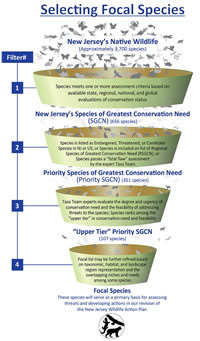NOTE: To access specific portions of the plan, please use the bookmarked Table of Contents on Page vii in New Jersey's State Wildlife Action Plan (pdf, 32mb)
New Jersey's State Wildlife Action Plan (SWAP) includes 656 Species of Greatest Conservation Need (SGCN) - a list of birds, mammals, reptiles, amphibians, fish, and invertebrates with low, declining, or vulnerable populations, and for whom conservation actions are needed to prevent or reverse declines over the next ten years (see Chapter 1, Section I - Process for Selecting SGCN and Focal SGCN) (pdf, 32mb). This is a long list, however, for a plan that aims to be focused and achievable in its goals. To refine our scope, the Division of Fish and Wildlife (DFW) used the SGCN list as the foundation for a tiered "filtering" process to arrive at a more manageable list of Focal Species. At every stage of the filtering process, a "taxa team" of experts within each taxonomic group assessed each species' conservation status, need, and the feasibility of successful conservation action, and reached consensus on their results. This approach led to a final list of 107 Focal Species. This is not meant to suggest that the state's conservation interests are limited to the 107 Focal SGCN. Rather, this focused approach will help achieve positive results for the various other SGCN not formally addressed within the Plan, but which share many of the same habitats and challenges as our Focal Species.
Most species' regional scores deferred to a Northeast Regional Conservation Synthesis ranking of "low" to "very high" based on the percentage of northeastern states within the species' range where it meets criteria for conservation concern. For species not ranked by the Northeast Regional Conservation Synthesis (particularly insects), scores were based on population trends and the risk of extirpation from New Jersey. New Jersey's responsibility scores were based on the percentage of a species' North American range that occurs within the northeast, and/or the risk of regional extirpation or extinction if the species should be lost from our state. Feasibility of success was assessed by two metrics: 1) Whether identified actions or strategies have been shown to benefit the species, and This exercise produced a list of 107 "Upper Tier" Priority SGCN (pdf, 490kb), for which our capacity to affect conservation is greatest. DFW's target number of "Upper Tier" species was around 100, presuming that such a list would represent the broad taxonomic groups, habitat types, and landscapes across New Jersey. To get a snapshot of this representation, the taxa team experts attributed each "Upper Tier" species with a taxonomic sub-class, as applicable (for example, birds were categorized as land birds or water birds, invertebrates as insects or non-insects, etc.). The list of "Upper Tier" species did represent the makeup of New Jersey's SGCN very well by both habitat and regional distribution. Focal Species The "Upper Tier" Priority SGCN list underwent a final "fatal flaw" analysis to ensure that scores for conservation need reflected the need in New Jersey. The outcome is a final list of 107 Focal SGCN; species of state and regional priority, representing the broad taxonomic groups, habitat types, and landscape diversity across New Jersey, for which there exists a notable capacity to positively affect their long-term conservation. The Focal SGCN are profiled in the SWAP (see Appendix D) (pdf, 32mb) and are noted among the list of New Jersey's SGCN (see Appendix B) (pdf, 32mb). Recognizing that synergies exist among species with overlapping habitats and life histories, the 107 Focal SGCN have been grouped by the taxa teams into guilds that reflect similarities in the species' taxonomies, ecological requirements, threats, and actions needed to conserve them. This assessment combined 77 of the Focal SGCN into 18 groupings, while the remaining 30 species remain ungrouped. This final categorization produced a list of 48 individual Focal SGCN and guilds of Focal SGCN (see Table 1 in Chapter 1, Section I.D.) (pdf, 32mb). The formal comment period for the revised NJ State Wildlife Action Plan has closed. We intend, however, to ensure that the Plan is a living document, and we welcome your continued input. The Plan will remain on our website with the ability to accept comments, which will be considered as we continue the process of assessing threats and developing and prioritizing appropriate conservation actions, for Conservation Focal Areas, focal species and their habitats. |
|||||||
|
||
|
|
||
|
||
| |
||

